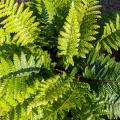Christmas Fern {flat of 32 Pots - 2 1/2 in}
|
|
Polystichum acrostichoides (AKA Nephrodium acrostichoides, Polystic Faux-acrostiche, Holiday Fern, Dagger Fern)
Pronunciation: pol-ee-STIK-um a-kros-tih-KOY-deez
Product: 999423
Product: 999423
Shipping description: This product can be shipped to all 48 continental states
FREE SHIPPING!
1-9 flats of 32 2.5" pots: $191.04 ($5.97 per plant)
10-99 flats: $181.49 per flat ($5.67 per plant)
100+ flats: $171.94 per flat ($5.37 per plant)
1-9 flats of 32 2.5" pots: $191.04 ($5.97 per plant)
10-99 flats: $181.49 per flat ($5.67 per plant)
100+ flats: $171.94 per flat ($5.37 per plant)
In stock.
| (minimum of 1) flat of 32 Pots - 2 1/2 in [ How many plants do I need? ] |
|||
|
|||
Also available as:
- Christmas Fern {Bare Root Plants, min 10}
On sale: $4.97
Discount: 29% - Christmas Fern {Bare Root Plants, min 25}
On sale: $3.97
Discount: 43% - Christmas Fern {1-Gallon pot}
$38.97 or less
Out of stock. Expected date unknown. Email when available - Christmas Fern {3 1/2 in. Pots min 25}
$9.87 or less
Out of stock. Expected 03/02/2026. Email when available
 (0)
(0)
 Part sun
Part sun  Shade
Shade
